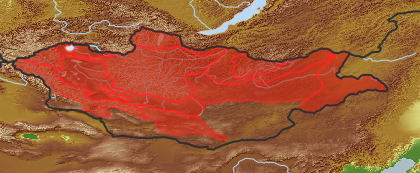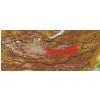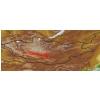| Class: | angiosperms |
| Order: | Ranunculales |
| Family: | Ranunculaceae |
| Genus: | Pulsatilla |
| Scientific name: | Pulsatilla bungeana C. A. Mey. |
| Name acc. to: | Gubanov 1996 |
| Herbar: | list records    |
| Description: | Plant 5-15 cm high. Stem and leaf petioles pilose. Blades of radical leaves 2 times pinnatisected, in outline oblong with numerous lateral segments. Flowers narrow-campanulate, erect, perianth segments 12-15(17) mm long. Achene awns 15-20(30) mm long. |
| Confuse with: | P. tenuiloba |
| Tax. Comments: | In Mongolia occurs in addition to the typical subspecies also subsp. astragalifolia (Pobed.) Grub.: Plant 5-10 cm high, densely adpressed pilose with once pinnate leaves. |
| Comments: | Smaller than most species with small flowers and with amazingly finely divided foliage, giving a feathery appearance. Distributed in the Altai mountains (Siberia and Mongolia). The species is often dominant in the mountain steppes.
|
| open map in a new window |  |
| Habitat: | rocks, steppe stony and debris slopes, montane steppes, dry pebbles (Grubov 2001) |
| Habit (i)general appearance of a plant | |
| Growth form: (i)Herb, shrub, tree or climber. | herb (i)Herbaceous, erect plant, up to 2m high, mostly with a leafy shoot; if perennial, shoots die to the ground each season, shoots are not woody
example: Artemisia pectinata   inherited by family Ranunculaceae: herb inherited by family Ranunculaceae: herb
|
| Parasite status: (i)Is the plant a half- or full parasite? | no parasite/saprophyte (i)Plant fully autonomous, leaves with chlorophyll
example: Most plants, Ranunculus  inherited by family Ranunculaceae: no parasite/saprophyte inherited by family Ranunculaceae: no parasite/saprophyte
|
| Water or terrestrial plant: (i)Where do the plants grow? | terrestrial (i)Plant grows on dry land
example: Orostachys spinosa  inherited by genus Pulsatilla: terrestrial inherited by genus Pulsatilla: terrestrial
|
| Leaf (i)expanded, usually photosynthetic organ of a plant (including phylloclades) | |
| Leaf development: (i)Structure and development of leaves. | with green leaves (i)Plant with green leaves  inherited by family Ranunculaceae: with green leaves inherited by family Ranunculaceae: with green leaves
|
| Leaf arrangement: (i)Arrangement of leaves at the stem. | alternate (i)One leaf per node; distiche: arranged in two vertical rows, equitant
example: Phragmites    inherited by genus Pulsatilla: alternate inherited by genus Pulsatilla: alternate
|
| Simple or divided leaves: (i)Are the leaves simple or completely divided in several parts? Blade of the leaf entire or (more or less) deeply dissected. Attention: There are various appearances of the leaf margin (from entire to toothed and lobed). Here, we ignore this and ask only for dissections that separate the leaf for more than one third of its length or width, whatever is smaller. Sometimes, it is difficult to tell apart compound leaves from a shoot system with simple leaves: look for stipulae and/or axillary buds at the ground of the leaves: if only some possess these structures, the others are most likely leaflets of a compound leaf. | compound (i)Composed of several similar parts  inherited by genus Pulsatilla: compound inherited by genus Pulsatilla: compound
complex divided (i)Divided into leaflets of more than second order
example: Artemisia gemelinii, Pulsatilla bungeana  inherited by genus Pulsatilla: complex divided inherited by genus Pulsatilla: complex divided
|
| Stipule: (i)Leaflets at the base of the petiole, these are smaller and of different shape. | none (i)Without stipules
example: Euphorbia, Ericaceae s.l.  inherited by family Ranunculaceae: none inherited by family Ranunculaceae: none
|
| Leaf veination: (i)Arrangement of the main veins of a leaf. | pinnate (i)One main vein, several side veins, sometimes inconspicuous
example: Cicerbita     inherited by family Ranunculaceae: pinnate inherited by family Ranunculaceae: pinnate
palmate (i)Several nearly equal main veins united at the point where the petiole inserts
example: Malva   inherited by family Ranunculaceae: palmate inherited by family Ranunculaceae: palmate
|
| Flower (i)reproductive portion of the plant, consisting of sepals, petals, stamens, and pistils | |
| Flower appearance and pollination: (i)General appearance of the flower. | attractive, animal-pollinated (i)attractive and coloured flowers, mostly large, attracting surely animals
example: Trollius, Rosa, Chamaerhodos  inherited by family Ranunculaceae: attractive, animal-pollinated inherited by family Ranunculaceae: attractive, animal-pollinated
|
| Flower symmetry: (i)Symmetry of the perianth leaves. Attention: to assess this character, look on sepals, petals and stamens, but neglect carpels and ovary. | radiary, regular (actinomorphic) (i)More than two axis of symmetry
example: Saxifraga: 5; Iris: 3   inherited by genus Pulsatilla: radiary, regular (actinomorphic) inherited by genus Pulsatilla: radiary, regular (actinomorphic)
|
| Flower form: (i)common forms of flowers ? Veronica | simple (flat) - Do not confuse with inflorescences as in some Asteraceae (i)Petals spread out, flower appearing flat
example: Mollugo, Trientalis, Pulsatilla, Saxifraga   inherited by genus Pulsatilla: simple (flat) - Do not confuse with inflorescences as in some Asteraceae inherited by genus Pulsatilla: simple (flat) - Do not confuse with inflorescences as in some Asteraceae
|
| Sepal fusion: (i)To which degree are the sepal leaves connected? Attention, this character applies only for flowers separated in sepals and petals, thus excluding most monocots. Be aware of the bracts (involucral leaves) of Asteraceae flowerheads, do not qualify these as sepals! | free (i)All leaves separate from each other
example: Geranium  inherited by family Ranunculaceae: free inherited by family Ranunculaceae: free
|
| Petal / Tepal fusion: (i)To which degree are the petal leaves connected? Petals sympetalous. | free (i)all petal leaves separate from each other
example: Anthriscus  inherited by family Ranunculaceae: free inherited by family Ranunculaceae: free
|
| Stamen number: (i)Attention: We ask for the reproductive organs of the flower dispersing pollen. Count only fully fertile stamens, not staminodia (e.g. Parnassia). | > 10 (i)
example: Nymphaea, Callianthemum, Rosa  inherited by family Ranunculaceae: > 10 inherited by family Ranunculaceae: > 10
|
| Stamen fusion: (i)To which degree are the stamens fused? Attention: Whereas the pollen sacs itself are often free., their stalks (filaments) may be fused. Here, we count them as fused if they are together over at least one thirth of their length. | free (i)Stamens with separate bases
example: Malus  inherited by family Ranunculaceae: free inherited by family Ranunculaceae: free
|
| Carpel number: (i)Number of carpels (carpel: forming a simple pistil or part of a compound pistil, modified leaf). | > 5  inherited by family Ranunculaceae: > 5 inherited by family Ranunculaceae: > 5
|
| Carpel fusion: (i)To which degree are the carpels (modified leaf forming simple pistil or part of a compound pistil) fused. | free (i)Carpels entirely free
example: Geum, Aconitum  inherited by family Ranunculaceae: free inherited by family Ranunculaceae: free
|
| Ovary position: (i)For entirely or partly fused carpels, describe their position in relation to the insertion point of perianth leaves (best done by doing a longitudinal section of a flower). | superior (hypogynous) (i)Base of carpels attached above insertion point of perianth leaves, carpels free or fused
example: Delphinium, Anemone    inherited by order Ranunculales: superior (hypogynous) inherited by order Ranunculales: superior (hypogynous)
|
| Sex: (i)Distribution of male and female organs among flowers, only most commonly cases. | bisexual, hermaphrodite (i)All or nearly all flowers of a plant with male and female parts
example: Haplophyllum, Chenopodium  inherited by family Ranunculaceae: bisexual, hermaphrodite inherited by family Ranunculaceae: bisexual, hermaphrodite
|
| Fruit (i)the seed bearing organ, with or without adnate parts; a ripened ovary and any other structures which are attached and ripen with it. Aggregate fruits are handled like simple fruits for determination. | |
| Consistency: (i)Fleshy fruits or dry fruits, see dispersal adaptations for further classification. | dry (i)With a dry outer shell, no fleshy parts, but seed (embryo) could be edible  inherited by family Ranunculaceae: dry inherited by family Ranunculaceae: dry
|
| Type of fruit: (i)Common fruit types (including pseudocarp). | Indehiscent fruits  inherited by genus Pulsatilla: Indehiscent fruits inherited by genus Pulsatilla: Indehiscent fruits
Solitary fruits (i)     inherited by genus Pulsatilla: Solitary fruits inherited by genus Pulsatilla: Solitary fruits
follicle (i)A pod arising from a single carpel, opening along a single side (the inner suture to which the seeds are attached)     inherited by genus Pulsatilla: follicle inherited by genus Pulsatilla: follicle
nut or nutlet (i)Dry fruit with a single, hard stone inside (and usually a large often edible embryo)   inherited by genus Pulsatilla: nut or nutlet inherited by genus Pulsatilla: nut or nutlet
Dehiscent fruits (i)Fruits open along a longitudinale line (except silicula)  inherited by genus Pulsatilla: Dehiscent fruits inherited by genus Pulsatilla: Dehiscent fruits
|
| Opening of fruit: (i)Mode of dehiscence at maturity to release seeds. | opening along dehiscent line (i)Opening along a preformed line
example: Vicia, Lathyrus: pods  inherited by family Ranunculaceae: opening along dehiscent line inherited by family Ranunculaceae: opening along dehiscent line
opening / dehiscent (i)Dry? Fruits opening with different types  inherited by family Ranunculaceae: opening / dehiscent inherited by family Ranunculaceae: opening / dehiscent
|
| Root / shoot below ground (i)plant part below ground (in most cases), including below ground shoots, without leaves | |
| Root type: (i)Organisation of the roots. | allorhizous (i)Plant with a conspicuous tap root, one larger tap root with side roots
example: Dicotyledonae  inherited by order Ranunculales: allorhizous inherited by order Ranunculales: allorhizous
|
| Runners: (i)Plant must be excavated; shoots, subterranean shoots connected by runners. | none (i)No runners or stolos visible
example: Dactylorhiza  inherited by family Ranunculaceae: none inherited by family Ranunculaceae: none
long root suckers or rhizomes (i)Plants grow new shoots from roots or subterranean shoots, called rhizomes, these spacing stems apart
example: Hippophae, Artemisia sericea  inherited by family Ranunculaceae: long root suckers or rhizomes inherited by family Ranunculaceae: long root suckers or rhizomes
stolons (i)Plants creep with above-ground shoots (stolons) which can root and establish new plants
example: Potentilla arenaria, P. anserina   inherited by family Ranunculaceae: stolons inherited by family Ranunculaceae: stolons
|
| Storage in below-ground structures: (i)Rhizomes or bulbs. | none (i)Plant with non-thickened roots, their maximum diameter does not exceed the diameter of the shoot base
example: Anabasis brevifolia  inherited by family Ranunculaceae: none inherited by family Ranunculaceae: none
storage rhizomes (i)Horizontal, root like structures with scale leaves or their scars, these clearly thicker than the bases of above-ground shoots
example: Petasites, Iris  inherited by family Ranunculaceae: storage rhizomes inherited by family Ranunculaceae: storage rhizomes
|
| Distribution (i)region where the plant is likely to be found | |
| Distribution (Veg. Zones): (i)acc. to Grubov 1952 | Khubsgul (i)In distribution data often named as '1' 
Khentei (i)In distribution data often named as '2' 
Khangai (i)In distribution data often named as '3' 
Mongol-Daurian (i)In distribution data often named as '4' 
Great Khingan (i)In distribution data often named as '5' 
Khobdo (i)In distribution data often named as '6' 
Mongolian Altai (i)In distribution data often named as '7' 
Middle Khalkha (i)In distribution data often named as '8' 
East Mongolia (i)In distribution data often named as '9' 
Depression of Great Lakes (i)In distribution data often named as '10' 
Valley of Lakes (i)In distribution data often named as '11' 
Gobi-Altai (i)In distribution data often named as '13' 
|
| Distribution Khangay: (i)acc. Flora Khangaya 1989 | I
II
III
V
VI
|